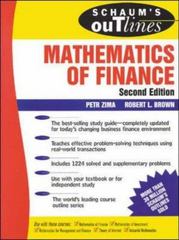Answered step by step
Verified Expert Solution
Question
1 Approved Answer
Sirotka Retail Company began doing business in 20X1. The following information pertains to its first three years of operation: Use the following links to the
Sirotka Retail Company began doing business in 20X1. The following information pertains to its first three years of operation: Use the following links to the present value tables to calculate answers. (PV of 1, PVAD of 1, and PVOA of 1) (Use the appropriate factor(s) from the tables provided.)
| Purchases | Sales | |||||||||||||||||
| Year | Operating Expenses | Units | Unit Cost | Units | Unit Price | |||||||||||||
| 20X1 | $ | 60,000 | 15,000 | $ | 20.00 | 12,000 | $ | 35 | ||||||||||
| 20X2 | 90,000 | 20,000 | 25.00 | 18,000 | 40 | |||||||||||||
| 20X3 | 65,000 | 5,000 | 30.00 | 10,000 | 40 | |||||||||||||
Assume the following:
- The income tax rate is 21%.
- Purchase and sale prices change only at the beginning of the year.
- Sirotka uses the LIFO cost flow assumption.
- Operating expenses are primarily selling and administrative expenses.
Required:
- Compute cost of goods sold and the cost of ending inventory for each of the three years.
- Prepare income statements for each of the three years.
- Compute the LIFO reserve at the end of 20X1, 20X2, and 20X3.
- Compute the effect of LIFO liquidation on the net income of the company for the years 20X2 and 20X3.
- Compute the inventory turnover ratio for the years 20X2 and 20X3. Do not make adjustments for any potential biases in LIFO accounting.
- How can the physical turnover of inventory (that is, true inventory turnover) best be approximated using all of the information available in a LIFO financial statement? Illustrate your approach by recomputing Sirotkas inventory turnover ratios for 20X2 and 20X3.
- Compute the gross margin percentages for the years 20X2 and 20X3.
- Provide an estimate of the FIFO cost of goods sold for the years 20X1, 20X2, and 20X3 using the information available in the financial statements.
- Based on your answers to requirements 1 and 8, estimate Sirotkas tax savings for 20X1, 20X2, and 20X3.
- Assuming a discount rate of 10%, compute the January 1, 20X1, present value of the tax savings over the period 20X120X3 (that is, discount the 20X1 tax savings one period, and so on).
Step by Step Solution
There are 3 Steps involved in it
Step: 1
The question is quite comprehensive and involves multiple calculations across various financial metrics Lets break it down stepbystep to ensure clarity and accuracy in solving each part of the problem ...
Get Instant Access to Expert-Tailored Solutions
See step-by-step solutions with expert insights and AI powered tools for academic success
Step: 2

Step: 3

Ace Your Homework with AI
Get the answers you need in no time with our AI-driven, step-by-step assistance
Get Started


